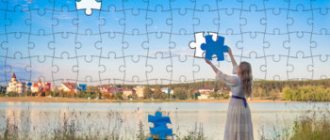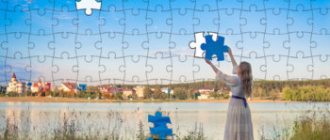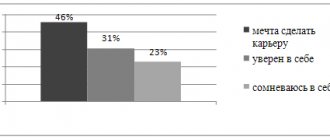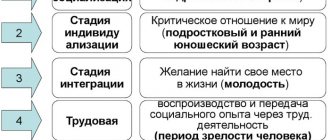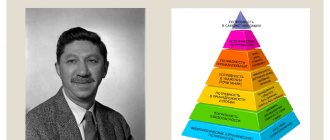The concept of imagination, its types, functions, mechanisms, physiological basis
As a subject of action, a person not only contemplates and cognizes, but also changes the world, transforms nature, creates objects that are not there. But a person could not do all this if he did not imagine the result of his actions. To transform the world in practice, you must be able to transform it mentally, imagining it.
First, a person becomes deeply acquainted with the image of the thing being created, forms his mental image, and then reproduces it when making a similar thing. But when a completely new thing is being made, there is no such rehearsal. Then a new image is created. This ability to create new images is called fantasy.
The process of imagination is manifested in the creation of something new - thoughts and images, on the basis of which new actions and objects are created. This is the creation of something that did not yet exist in reality.
The images with which a person operates include not only perceived processes and phenomena. These can be events, facts, phenomena, witnesses that a person did not have and could not have. Images of the imagination may contain inevitable, desired, possible events and phenomena. And at the same time, something new, created in the imagination, is always connected with what really exists. Images of the imagination are based on memory representations, but are subject to transformation in the imagination. According to R.S. Nemova, imagination is the ability to imagine an absent or unreal object, hold it in consciousness and mentally manipulate it.
Imagination is associated with all aspects of human activity, with memory, perception, thinking. Thus, the perception of works of art becomes more meaningful, more emotional, when it includes imagination. L.S. Vygotsky said: “The creative activity of the imagination directly depends on the richness and diversity of a person’s previous experience, because experience is the material from which the constructions of the imagination arise. The richer a person’s experience, the more material his imagination has.” The connection between imagination and thought is clearly manifested in a problem situation. Faced with the unknown, a person begins to analyze, synthesize, correlate what is perceived with previous experience, trying to penetrate into the essence of the relevant facts and phenomena. In this process, he is helped not only by thinking and memory, but also by imagination, because it creates a complete picture and fills in the missing elements. The process of imagination is peculiar only to man and is a prerequisite for his work activity.
Types of imagination differ in the degree of activity and consciousness with which a person creates new images. Depending on this, a distinction is made between involuntary (passive) and voluntary (active) imagination. In the involuntary imagination, new images are formed under the influence of poorly realized needs, aspirations, and attitudes. Such imagination works when a person is asleep, in a sleepy state, in a thoughtful state, etc.
Voluntary imagination is the process of consciously constructing images in connection with the goal pursued by a particular type of activity. Voluntary (active) imagination arises at an early age; it is most developed in children's play. In role-playing games, children take on different roles; during the game, active imagination is required, since it is necessary to correctly structure their behavior in accordance with the role taken on. In addition, you need to imagine the missing objects and the action of the game.
Free imagination is divided into recreated and creative. Restorative imagination is characterized by the fact that in its process new images are subjectively formed, which are new to a person, but objectively they already exist, embodied in certain cultural objects. The essence of the reconstructed imagination is that a person reproduces, reproduces what he did not perceive, but what other people convey to him through language, drawings, diagrams, signs, and so on.
There must be a connection between images and ordinary symbols, as well as decoding signals, symbols and signs.
Thus, reconstructive imagination is the creation of a new image based on verbal descriptions, the perception of images in the form of pictures, diagrams, maps, drawings, mental and material models.
Creative imagination plays an important role in human life. It allows you to exchange experiences, helps each person to master the experiences and achievements of other people.
Question 3. Physiological basis of imagination processes
Imagination, like all other mental processes, is a function of the cerebral cortex. Scientists suggest that the physiological mechanisms of imagination are located not only in the cortex, but also in deeper parts of the brain. This is the hypothalamic-limbic system.
The brain has a regulatory effect on the peripheral parts of the body and changes the process of their functioning. Let's give examples. When Flaubert wrote the scene of the poisoning of the heroine of the novel Madame Bovary, he felt the taste of arsenic in his mouth. Every year on the anniversary of St. Bartholomew's Night, Voltaire began to have an attack of fever: his temperature rose and his pulse increased sharply. Shereshevsky, a man with a phenomenal memory and vivid imagination, could speed up the rhythm of his heart (imagine himself running after a tram), slow it down (imagine himself lying on a bed), could increase the temperature of his right hand by 2 degrees (imagine that his right hand was lying on the edge of a hot stove), and lower the temperature of your left hand by 1.5 degrees (imagine that you were holding a piece of ice).
Ideomotor acts are known that affect the reactivity of the vascular system. These are movements that arise when a person only imagines them. For example, imagine that a pendulum - a string with a load - begins to describe circles. After some time this happens. A vivid representation of the movement causes muscle efforts that are not registered by consciousness, which set the pendulum into a circular motion.
Question 4. Types of imagination
Students independently develop the specified topic, collect material, and then discuss it in class.
Question 5. Individual characteristics of imagination
Imagination varies among people according to several characteristics: the brightness of images; the degree of their realism and truthfulness, novelty and originality; breadth of imagination; arbitrariness, i.e. the ability to subordinate the imagination to the task at hand (highly organized and disorganized imagination); the type of ideas that a person primarily operates with (visual, auditory, etc.); sustainability.
B.B. Aismontas refers to the individual typological features of the imagination: the imagery of the recreating imagination (reciprocity of signaling systems); reflective capabilities; creative capabilities of the individual; subordination of the present to long-term goals; spirituality, romanticism, dreaminess; ability to foresee events.
I.V. Dubrovina and other psychologists believe that the individual characteristics of imagination are determined by the degree of ease and difficulty with which the process of imagination is generally given to a person; the characteristics of the created image itself (absurdity or an original solution); personal orientation (in which area the creation of new images is brighter and faster).
Question 6. Development of children's imagination
According to T. Ribot, there are four stages in the development of imagination. The first stage is the transition from passive to creative imagination, starting with imitation; the second is animism, or animation, of surrounding objects; third - game; the fourth is the romantic stage.
Factors and conditions influencing the development of imagination: children's horizons; expressiveness of teachers' speech; performing activities that require imagination; training in the conscious use of heuristic methods, i.e. methods of obtaining new knowledge.
I.V. Dubrovina and other researchers believe that the main condition for the development of a child’s imagination is its inclusion in a wide variety of activities. As a child develops, his imagination also develops. The more a child has seen, heard and experienced, the more he knows, the more productive the activity of his imagination will be - the basis of all creative activity. Imagination can be trained and developed in different ways, but always in activities that, without imagination, cannot lead to the desired results. We must teach children to see the most familiar things from an unexpected, new side, which is a necessary condition for creativity. Various clubs are of great importance for the development of children’s creative imagination: artistic, literary, technical, young naturalists and others. Younger schoolchildren enjoy inventing fairy tales and writing essays, including on a free topic. You can come up with many tasks to develop your imagination on a trip out of town: “Imagine that we are lost,” “We are on a desert island.” Next, the children act out the plot, and the adult tactfully guides their wild imagination and teaches the children to control their imagination.
The following stages of creative imagination can be distinguished:
1. The emergence of a creative idea;
2. “Nursing” the idea;
3. Its implementation.
Materials for practical classes.
Exercise
Group members sitting in a circle non-verbally pass an object around the circle after doing something with it.
Conduct the discussion in the direction opposite to the movement of the object. Each participant says what item he received, what he did with it, and what he passed on around the circle. Pay attention to the reasons for each other's mistakes.
Stages of imagination development in ontogenesis
The ability to imagine is not given at birth. Imagination develops with the accumulation of practical experience, the acquisition of knowledge, and the improvement of all mental functions. In modern psychology.
There is a large number of studies devoted to the development of imagination in ontogenesis. Basically, the age periods of development and the type of activity in which it developed were studied. There are the following stages of imagination development:
The first stage (from 0 to 3 years) - the prerequisites for imagination are ideas that appear in the second year of life. A child aged about one and a half years recognizes the image. It is her imagination that helps her recognize the picture. She constructs something that does not quite fit into the memory of the representation. By recognizing, the child does not create anything new. Therefore, imagination is a passive process. It exists within the framework of other mental processes, and its basis is laid in them. The child's ability to act in an imaginary situation with imaginary objects indicates the first manifestations of imagination. The first imitation games that appear in the second year of life do not yet contain elements of imagination. One of the reasons for the emergence of fantasy is the psychological distance between the child and the adult, the child and the object of his desire. The child perceives the basic actions of an adult, but reflects them in a generalized and conditional manner, conveying only their meaning and external design.
The development of the first forms of imagination in early childhood is associated with the generalization of play actions and play objects, as well as
The repertoire of game actions firmly includes substitutions.
According to V.A. Skorobogatova and L.I. Konovalova, the baby does not immediately respond to the replacements offered by adults, but plays only with real toys. The turning point comes when the child refuses to use any substitute offered by adults. The most important factor ensuring the possibility of transmitting meaning to other objects is the emergence of linguistic forms. Mastering the language leads to the appearance of the first independent substitutions in the game. There's a new way to work with replacement objects—using replacements entirely. Selecting Replacement Objects
substitutes comes into consciousness and is accompanied by detailed statements. Thus, creative elements arise in the play activities of young children. The child, against the backdrop of interest in a new type of activity, quickly begins to deviate from the courses of action given by adults and introduces his own nuances into them. But imagination is reproductive.
The second stage (from 3 to 4 years) is the formation of verbal forms of imagination. In the third year of life, the need for play activities becomes an independent need of the child, although it requires support and encouragement from an adult. The basis of the game is the unfolding orientation towards the plot side of human activity. This orientation begins with imitation of the actions of an adult and develops along the path of independent creative construction of images of action with objects, even with reference to real objects. Consequently, indicators of the development of imagination in the game are: a variety of actions acting in an imaginary situation, independent choice of a replacement object, flexibility in changing the functions and names of objects, originality in the substitution of game actions, criticality of the partner’s substitutions.
Affective imagination develops, which is associated with the child’s awareness of his “I” and differentiation from other people. Imagination is already becoming an independent process.
The third stage (from 4 to 5 years) - at this age the activity of creative manifestations increases, especially in play, handicrafts, storytelling and retelling. Dreams about the future appear. They are situational, often unstable, caused by events that provoked an emotional reaction in the child. Imagination becomes a special intellectual activity aimed at transforming the world around us. The image is not only based on real
Imagination as a fundamental component of the creative process
We have already mentioned the direct connection between imagination and creativity. Therefore, we consider it necessary to dwell in detail on the psychology of creativity.
The psychology of creativity as a science began to take shape at the turn of the 19th-20th centuries. Science began with the stage of contemplative psychological knowledge. Psychologists have described in detail the circumstances of the emergence of great works of science and art, using biographies, autobiographies, memoirs, and literary works. He studied the nature of creativity, the stages of the creative process, creative abilities and qualities of a creative personality. The traits of a genius were assigned, expressed in the characteristics of perception (intensity of attention, great impressionability, receptivity), intelligence, character, motivation and value orientation. However, there were no means to penetrate into the essence of the described phenomena: Since psychological methods for obtaining initial data were limited to introspection, the essence of creativity was recognized as unconscious processes.
Until the mid-twentieth century, psychology linked creativity with intellectual development. The need to determine intellectual abilities led to the development of IQ tests - mental ability tests. However, studies by many psychologists have shown that there is no direct dependence of creative abilities on intelligence and the amount of knowledge, that is, there is no correlation between IQ and the ability to create something new - creativity.
The study of the phenomenon of creativity is complicated by the fact that when assessing creative qualities, the researcher primarily cares about the quality of the phenomenon. A study of creativity using our own scientific material was carried out in 1959 by a group of scientists led by J. Guilford using factor analysis using material from the exact sciences. Simultaneously and independently of Guilford, a series of experiments on art material were carried out in the same 1959 by W. Löfeld and K. Beittel. Comparison of research results revealed 8 main criteria that are natural for making distinctions:
» * Ability to recognize a problem.
- Fluency, the ability to see as many sides and connections to a problem as possible.
- Flexibility as an ability
- to understand a new point of view;
- reject a learned point of view.
- Originality, the ability to deviate from the template.
- Ability to regroup ideas and connections.
- The ability to abstract or analyze.
- Ability to be concreted or synthesized.
- A sense of orderly organization of ideas."
Moreover, creativity in art and science has common features that allow creativity to be transferred from one material to another.
The field of creativity is difficult to study and controversial because the empirical field of evidence on this issue is very broad. However, creativity as a phenomenon has many supporters. These researchers often consider four main aspects together: the creative environment, the creative person, the creative product, and the creative process.
Creative environment. Creativity manifests itself through personal feeling, thinking, knowledge, sensation, action as behavior in a state of relative safety, freedom from the environment. Creativity is the perception, reaction, action or communication of a person who is not influenced by other people and is in a natural environment.
Creative person. Understanding the importance of subjective personal factors in their interaction with objective factors in the study of creative processes has led to taking into account the personal factor in recent decades. Thus, following other sciences, the psychology of creativity, which studies personality with the entire spectrum of its qualities, introduces the principle of systematics into its methodology.
Functions of the imagination
Imagination plays a huge role in human activity, and we are talking not only about the processes of cognition or creativity. We can say that without imagination you can’t build a house or cook soup. Such a multifaceted participation of this mental process in human life is evidenced by its various functions.
Prognostic function
Anticipating possible results of an activity is considered a fundamental function of the imagination. Paleopsychologists suggest that it is this function that underlies the emergence of not only imagination, but also figurative thinking in general. By the way, higher animals also have the rudiments of imagination in the form of foresight. People who have pets know that if a cat or dog does not greet its owner when he comes home from work, but hides, it means they have done something and anticipate the person’s reaction.
Cognitive function
Along with thinking, imagination is involved in the process of processing information entering the brain. It is his merit that we can store in memory and then reproduce images with incomplete knowledge. For example, a silhouette is enough to distinguish a picture of a dog from a picture of a cat. We can see a person half-turned, and the imagination will fill in what is missing, and a complete image will be preserved in memory. Sometimes, however, our ideas about an object are very different from the object itself. And this is also the “merit” of the imagination.
Conversion function
This function is associated with operations with images and enables another very important process - creativity. Creativity is, in essence, an activity associated with the embodiment of imaginary images into reality. Not only art and science, but all productive activities, which means the development of human civilization, is based on this function of the imagination.
Planning function
Imagination provides the ability not only to foresee the results of an activity, but also to plan this activity, draw up a kind of program or scheme, and outline the path along which we can reach our goal.
Psychotherapeutic or compensatory function
At the level of imagination, a person can compensate for what he lacks in reality. Dreams and reveries are a type of imagination that brings a person a feeling of satisfaction, although it does not satisfy any real needs. However, imagining what you want, dreaming about it, a person relieves mental stress, which can lead to an emotional breakdown. Imagination in this case does not solve the problems that have arisen in front of a person, but it helps to accept a situation that he cannot change, or to get rid of obsessive depressing thoughts and experiences.
These are just the most basic functions of the imagination. In fact, not a single manifestation of mental activity can do without it:
- Imagination makes empathy and compassion possible, since we can imagine the emotions that another person is experiencing.
- It regulates our behavior, presenting us with pleasant or unpleasant images, “warning” us about the possible consequences of our actions.
- It simply makes our life brighter, fuller and more voluminous.
